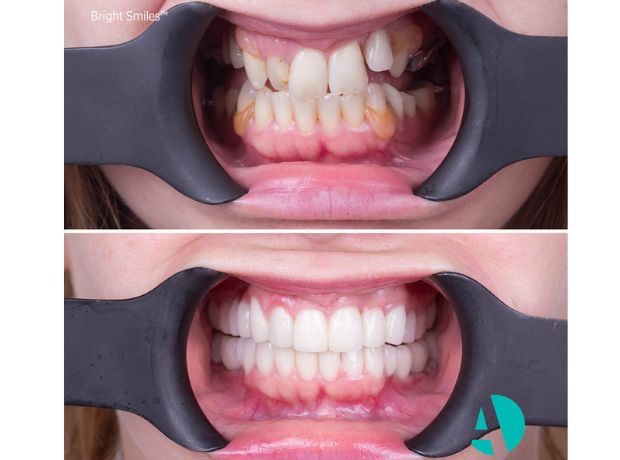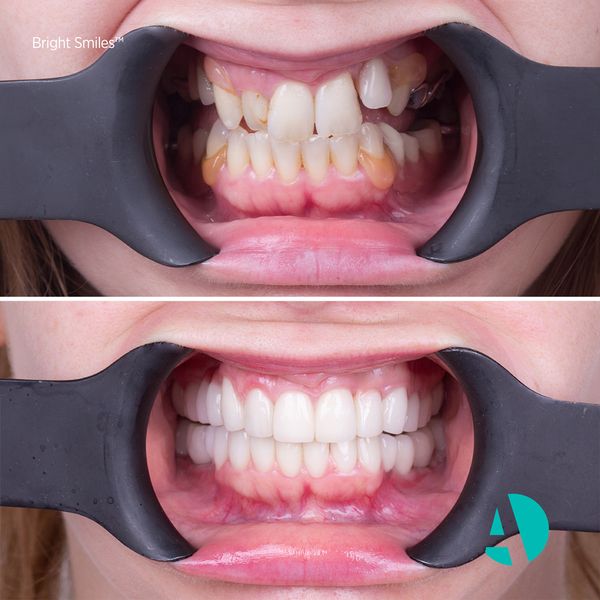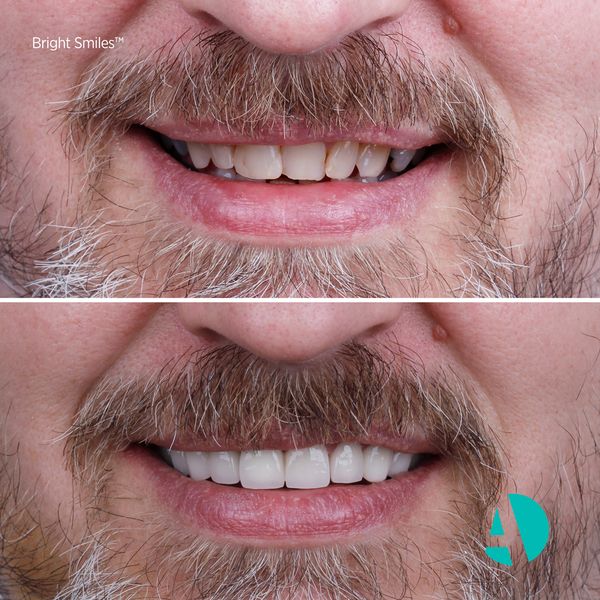Orthodontics Treatment (Dental Braces)
Orthodontics treatment is a highly-specialized branch of dentistry that straightens or moves teeth to improve their appearance and function. It can also help protect the long-term health of your teeth, gums, and jaw joints by distributing biting pressure evenly.
Orthodontics treatment in Europe and USA is incredibly expensive. Visiting Turkey for dental surgery doesn't mean sacrificing quality. Dental and orthodontics services in Turkey are as good as what you would find in Europe. First-time dental visitors are often astonished by Turkey's excellent facilities.
Get a free quote
12-36 MONTHS
CONTACT US FOR DETAILED INFORMATION
CONTACT US FOR DETAILED INFORMATION
CONTACT US FOR DETAILED INFORMATION
Orthodontics in Turkey

Orthodontic treatment deals with correcting the appearance and alignment of crooked teeth. The treatment is initiated after most of the child's adult teeth have begun to emerge. This is usually around the age of 12, but it depends on how many adult teeth have emerged. For adults, the treatment can begin at any age, but their options are more limited.
What is Orthodontic Treatment?
Orthodontics treatment is a highly-specialized branch of dentistry that straightens or moves teeth to improve their appearance and function. It can also help protect the long-term health of your teeth, gums, and jaw joints by distributing biting pressure evenly.
Straightening your teeth may appear to have only cosmetic benefits, but this could not be further from the truth. Since the proper alignment of the teeth affects the chewing and biting abilities, it has many useful effects on your general health.
It is difficult to clean a crooked tooth which leads to tooth decay or periodontal disease. Teeth that do not fit properly can make chewing difficult, causing headaches, back pain, and even temporomandibular joint (TMJ) disorders.

What Are the Different Types of Orthodontic Treatments?
Mostly there are 4 primary categories of braces:
- Metal braces
- Ceramic braces
- Lingual braces
- Clear aligners (Invisalign)
Metal Braces
Metal braces are the most popular and oldest version of braces. With the help of technology and innovations, they are now smaller, more comfortable, and more practical. Also, metal braces are children's and adolescents' favorite choices.
The orthodontist applies braces to the teeth, connects them with a wire, and makes adjustments on the wire every 4 to 8 weeks. Maintaining proper dental hygiene and caring for metal braces are essential throughout treatment.
Ceramic Braces
Ceramic braces are a less visible and affordable alternative to metal braces. They are mostly preferred by those who don’t like to use Invisalign or lingual braces but would like to be esthetically driven. Their biggest disadvantage is that brushing and nutrition can stain them.
Lingual Braces
This treatment requires some orthodontics skills that are peculiar to it. A highly experienced dentist must do the treatment. With this method, the dentist seals the braces behind the teeth, so it is well-suited for those who don’t want to have noticeable braces.
Clear Aligners (Invisalign)
The Invisalign braces have been popular since the 2000s, and now they have become the largest brand of aligners. With this technique, the dentist applies transparent plaques to the teeth. They offer some advantages to users that can’t be ruled out.
- Removable
- Clear and transparent
- Allow for easier cleaning
- Shorter appointments
At Antlara Dental, Orthodontist Ugur Agar serves his patients with 25 years of experience. Since 1998 he has worked in Turkey’s biggest hospitals, GATA, and others. He has published many scientific articles, many of which were published in famous journals in the field.

How Long Does Orthodontic Treatment Take?
On average, 24 months is enough to complete an orthodontics treatment. But each patient’s mouth is unique. While some patients require less than 12 months, others may require up to 36 months. It is hard for an orthodontist to tell the exact treatment period, but the factors that influence the treatment time can help us understand it.
Age
Younger patients' teeth are less thick and continue shifting and growing. To move teeth into the correct alignment, the procedure could take less time or require less effort. The ages of 9 and 14 are the most preferred ages for orthodontic treatments since the face structure continues to develop and there are both baby and adult teeth.
The severity of the condition
More serious jaw alignment takes longer. The treatment may require creating more space, readjusting, and extracting teeth.
Oral Hygiene
Throughout the treatment, the patient should keep away from sugary, hard, and sticky foods and avoids chewy. The patient should also keep clean his teeth and braces regularly.

How Much Does Orthodontic Treatment Cost?
The cost of each type of brace significantly varies. The time necessary for the treatment is also another important cause of the cost. So it is difficult to make a price list based on this treatment. But here is a comparison of different types of braces at different locations. The list includes dual arch treatment.
Benefits of Orthodontics Treatments
Orthodentic has lots of benefits as it concentrates on remedying some of the dental problems which otherwise can’t be prevented with normal dentistry. Let’s have a short look at some of its benefits.
1. It decreases the dental damage risk
The unified structure of teeth absorbs the outside shock and prevents the possibility of cracking.
2. Helps easier cleaning.
Badly aligned teeth cause food particles to get stuck between them. If food is allowed to remain between your teeth, the possibility of infection increases.
3. Reduce the strain on the jawbone.
If the jaw structure and teeth alignment is complicated, the brain notices the uneven pressure and unnaturally changes the chewing style. This cause many aching problems in the body.
4. Increase self-confidence
People with misalignment teeth can’t smile as they wish, so this situation negatively influences their psychology. So patients’ confidence increase with the correction of teeth structure.
Is Orthodontic Used for Only Children?
There is no age limit for orthodontics treatment. If the person’s health condition permits, it can be done at any age. But orthodontics treatment is usually applied to children because they are always given priority in treatment, and many adults complete their treatment at early ages.
Orthodontic Treatment in Turkey
Traveling to Turkey for braces treatment can save you a lot of money. Orthodontics treatment in Europe and USA is incredibly expensive. Visiting Turkey for dental surgery doesn't mean sacrificing quality.
- The quality is comparable to Europe
There is a misconception about compromising on the quality of service when choosing a Turkish dentist. In reality, the dental and orthodontics services in Turkey are as good as what you would find in Europe. First-time dental visitors are often astonished by Turkey's excellent facilities.
- More Affordable
Patients can combine their treatment with a short vacation, and the overall cost will be cheaper than the cost of the treatment in Europe.
- Labor is Cheaper
Turkish dental clinics can hire employees for significantly less money than they might in Europe.
- Accommodations Facilities
Turkey is a famous touristic country with its beautiful sea shores. There are many big cities like Antalya where you can find good accommodations. The clinics also help you find the best places.
Orthodontics Treatment (Dental Braces) FAQ
Orthodontics Treatment (Dental Braces) - Antalya- Smooth teeth help the person to bite, chew and speak effectively.
- Contributes to healthy teeth and gums.
- The susceptibility to gum disease and caries decreases.
- It prevents the development of different functional problems (joint complaints, etc.) that teeth are both better in function and appearance and appear more aesthetic.
In cases that cannot be corrected by orthodontic or orthopedic treatment, orthognatic surgery is applied. Disorders of the jaw and face may occur after birth or due to accidents and diseases. The mismatch of the jaws with respect to each other and face leads to both aesthetic and functional disorders in patients. With the help of advanced technology and surgical techniques, these disorders can be corrected.
Orthodontic examination is sometimes useful in children aged 5-6 years. Although orthodontic treatment is not applied at this age, some preventive orthodontic treatments are very useful. Orthodontic treatments to be applied at these ages are called preventive and protective orthodontic treatments.
- Metal braces
- Invisalign
- Ceramic braces
Many different appliances are used to make the proper position of teeth, muscles, and jaws in the teeth straightening process. These appliances work by placing gentle pressure on the teeth and jaws. The severity of your problem will determine which orthodontic approach is to be taken for a more effective result. The most widely used types of orthodontics appliances are;
At every visit, you should change your elastics, and you might also need to replace, modify, or tighten your wires.
In fact, braces can be an excellent alternative for those who are missing a tooth since they can narrow or expand gaps to provide room for a replacement.
The ideal time to begin braces treatment for children is often when they have lost most or all of their baby teeth. The typical age for children ranges between 11 and 14. But it is accepted that a 7 years old child can have orthodontics treatment if needed.
Braces can cause pain or discomfort, but it is not too much. The first time you put on your braces, you don’t feel pain. After that, your dentist puts bands around your back molar and applies special glue. Within a few hours, some pain and soreness begin to develop. This pain usually lasts one week. Your dentist prescribes some medicine for that pain until you get used to it.
- Genetic factors
- Incorrect functions (mouth breathing, etc.)
- Harmful habits (finger sucking, long lying pacifier use, etc.)
- Early loss of deciduous teeth
- Trauma
